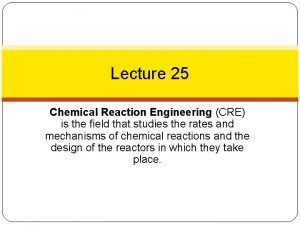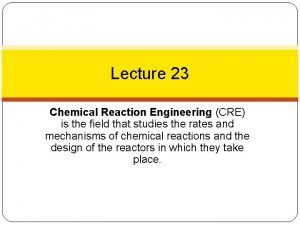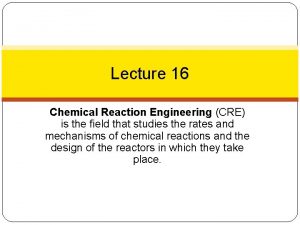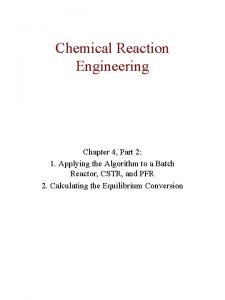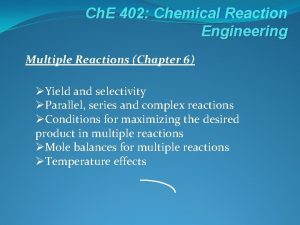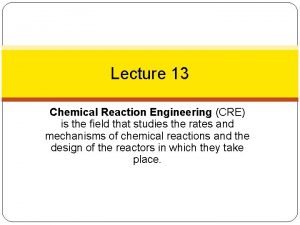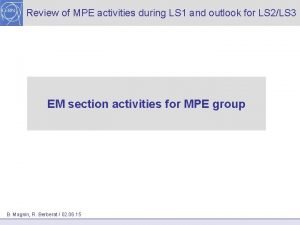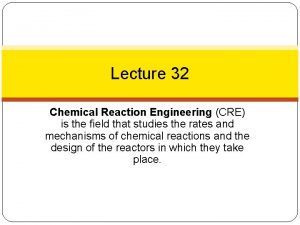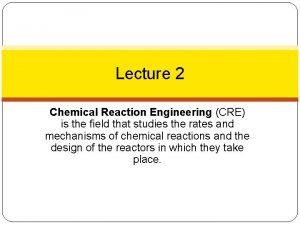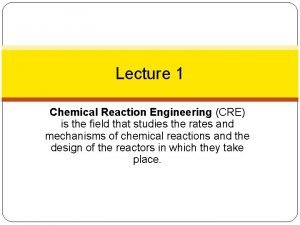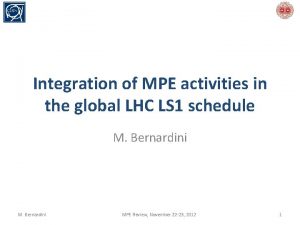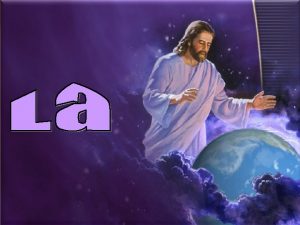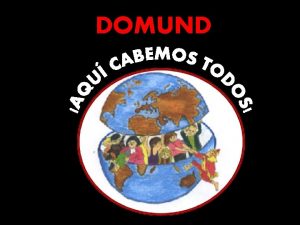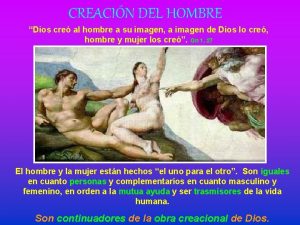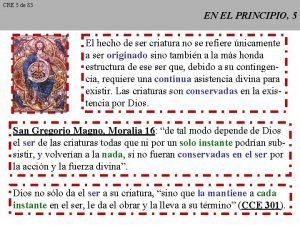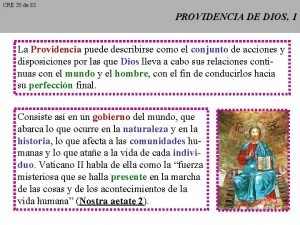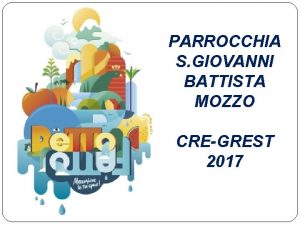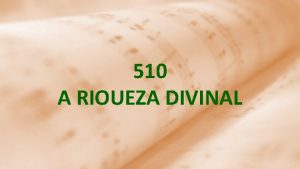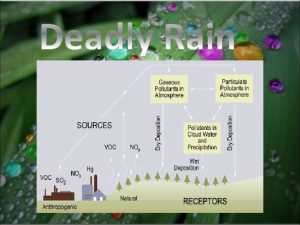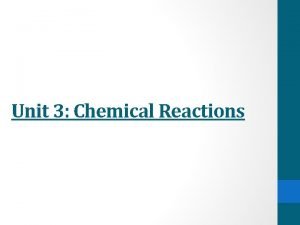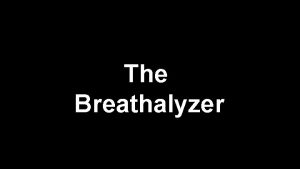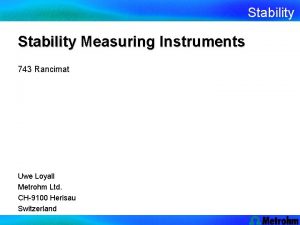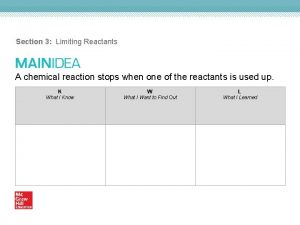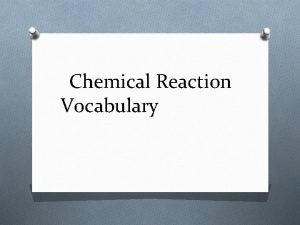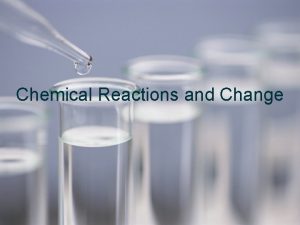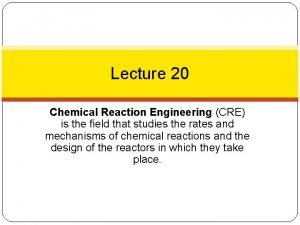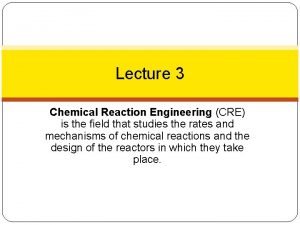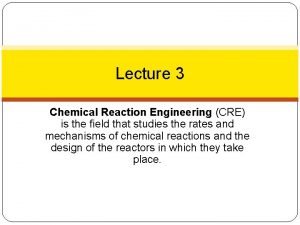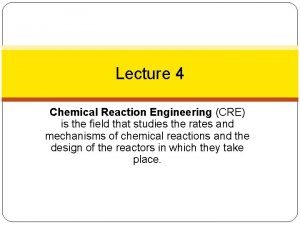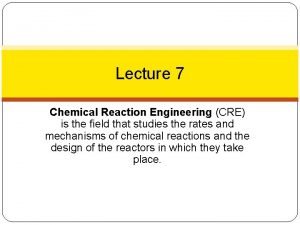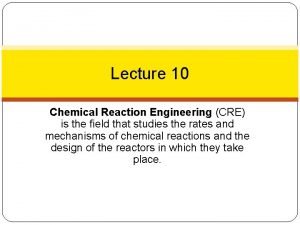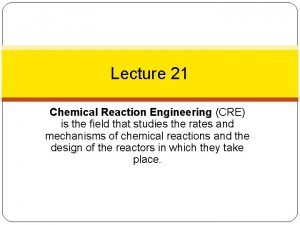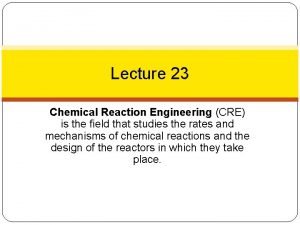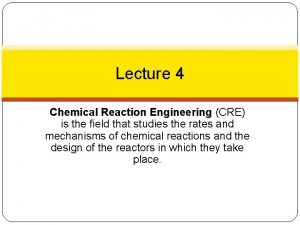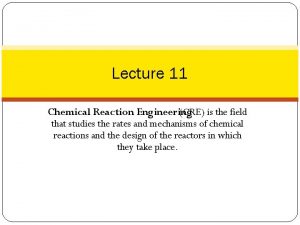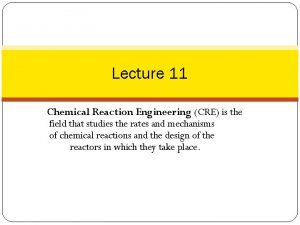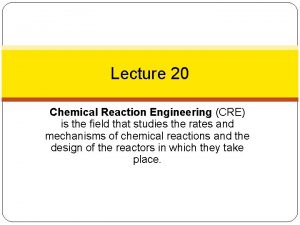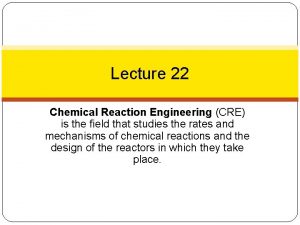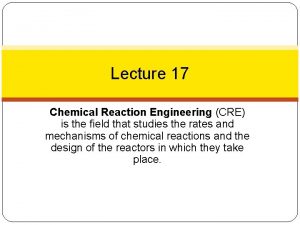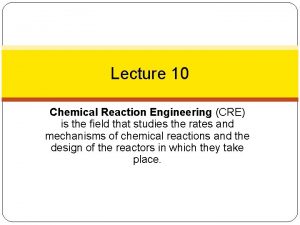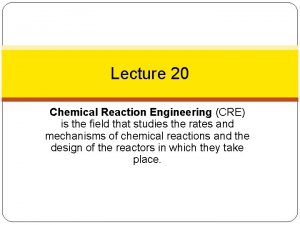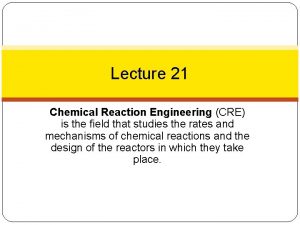Lecture 3 Chemical Reaction Engineering CRE is the






































- Slides: 38

Lecture 3 Chemical Reaction Engineering (CRE) is the field that studies the rates and mechanisms of chemical reactions and the design of the reactors in which they take place.

Chapter 3 Lecture 3 � Review of Lectures 1 and 2 � Building Block 1 �Mole Balances (Review) �Size CSTRs and PFRs given –r. A= f(X) �Conversion for Reactors in Series � Building Block 2 �Rate Laws �Reaction Orders �Arrhenius Equation �Activation Energy �Effect of Temperature 2

Review Chapter 1 Building Block 1: Mole Balance The GMBE applied to the four major reactor types (and the general reaction A B) Reactor Differential Algebraic Building Blocks Integral NA Batch t CSTR FA PFR V PBR 3 FA W

Review Chapter 2 4

Review Chapter 2 Building Block 1: Mole Balance In terms of Conversion Building Blocks Reactor Differential Algebraic Integral X Batch t CSTR PFR X PBR 5 W

Review Chapter 2 Levenspiel Plots 6

Review Chapter 2 Reactors in Series Only valid if there are no side streams 7

Review Chapter 2 Reactors in Series 8

Chapter 3 Building Block 2: Rate Laws Power Law Model: 9 Building Blocks

Chapter 3 Building Block 2: Rate Laws Building Blocks A reactor follows an elementary rate law if the reaction orders just happens to agree with the stoichiometric coefficients for the reaction as written. e. g. If the above reaction follows an elementary rate law 2 nd order in A, 1 st order in B, overall third order 10

Chapter 3 Building Block 2: Rate Laws 2 A+B 3 C If › Second Order in A › Zero Order in B › Overall Second Order 11 Building Blocks

Chapter 3 Relative Rates of Reaction 12

Chapter 3 Relative Rates of Reaction Given Then 13

Reversible Elementary Reaction A+2 B 14 k. A k-A 3 C Chapter 3

Reversible Elementary Reaction A+2 B 15 k. A k-A 3 C Chapter 3 Reaction is: First Order in A Second Order in B Overall third Order

Chapter 3 16

Chapter 3 The Algorithm How to find Step 1: Rate Law Step 2: Stoichiometry Step 3: Combine to get 17

Chapter 3 Arrhenius Equation k is the specific reaction rate (constant) and is given by the Arrhenius Equation. where: k 18 T

Chapter 3 Arrhenius Equation where: E = Activation energy (cal/mol) R = Gas constant (cal/mol*K) T = Temperature (K) A = Frequency factor (same units as rate constant k) (units of A, and k, depend on overall reaction order) 19

Chapter 3 Activation Energy Concept 1. Law of Mass Action The rate of reaction increases with increasing concentration of reactants owing to the corresponding increase in the number of molecular collisions. The rate of disappearance of A, –r. A, depends on temperature and concentration. For many irreversible reactions, it can be written as the product of a reaction rate constant, k. A, and a function of the concentrations (activities) of the various species involved in the reaction: (3 -2) For example for the elementary reaction E = Activation Energy, (k. J/mol) 20

Chapter 3 Collision Theory C AB C UR 21

Why is there an Activation Energy? Chapter 3 We see that for the reaction to occur, the reactants must overcome an energy barrier or activation energy EA. The energy to overcome their barrier comes from the transfer of the kinetic energy from molecular collisions to internal energy (e. g. Vibrational Energy). 1. The molecules need energy to disort or stretch their bonds in order to break them and thus form new bonds 2. As the reacting molecules come close together they must overcome both stearic and electron repulsion forces in order to react. 22

Chapter 3 Activation Energy Concept 2. Potential Energy Surfaces and Energy Barriers As two molecules, say AB and C, approach each other, the potential energy of the system (AB, C) increases owing repulsion of the molecules. The reaction coordinate is a measure of progress of the reaction as we go form AB and C to A and BC as shown in Figure 3 -2 below. 23

Chapter 3 Activation Energy Concept 2. Potential Energy Surfaces and Energy Barriers The figure below shows a 3 -dimensional energy surface and barrier over which the reaction must pass 24

Chapter 3 Activation Energy Concept 2. Potential Energy Surfaces and Energy Barriers 25

Chapter 3 Activation Energy Concept 3. Fraction of Molecular Collisions That Have Sufficient Energy to React The kinetic energy of the molecule must be transferred to potential energy to distort bonds and overcome steric forces in order for the reacting molecules to pass over the energy barrier. The distribution of velocities of the reacting molecules relative to one another is given by the Boltzmann distribution Where 26 k. B = Boltzmann’s constant = 3. 29 x 10– 24 cal/molecule/K m = Reduced mass, g U = Relative velocity, m/s T = Absolute Temperature, K e = Energy = m. U 2, kcal/molecule E = Kinetic energy, kcal/mol f(U, T) = Fraction of relative velocities between U and U + d. U

Chapter 3 Activation Energy Concept 3. Fraction of Molecular Collisions That Have Sufficient Energy to React Distribution of Velocities We will use the Maxwell-Boltzmann Distribution of Molecular Velocities. For a species of mass m, the Maxwell distribution of velocities (relative velocities) is: f(U, T)d. U represents the fraction of velocities between U and (U+d. U). 27

Chapter 3 Activation Energy Concept 3. Fraction of Molecular Collisions That Have Sufficient Energy to React Distribution of Velocities A plot of the distribution function, f(U, T), is shown as a function of U: T 1 T 2>T 1 28 U Maxwell-Boltzmann Distribution of velocities.

Chapter 3 Activation Energy Concept 3. Fraction of Molecular Collisions That Have Sufficient Energy to React Distribution of Velocities Given Let f(E, T)d. E represents the fraction of collisions that have energy between E and (E+d. E) 29

Chapter 3 Activation Energy Concept 3. Fraction of Molecular Collisions That Have Sufficient Energy to React In terms of energy per mole, E, instead of energy per molecule, e, we have (3 -20) where E is in (cal/mol) or (J/mole), R is in (cal/mol/K), and f(E, T) is in mol/cal. The distribution function f(E, T) is most easily interpreted by recognizing that [f(E, T) d. E] is the fraction of collisions with energies between E and E + d. E. (3 -21) This distribution is shown as a function of E for two temperatures in the next slide. 30

Chapter 3 Activation Energy Concept 3. Fraction of Molecular Collisions That Have Sufficient Energy to React This fraction is shown by the shaded area in Figure 3 -4(a) and is approximated by the average value of f(E, T) at E = 0. 3 kcal/mole is 0. 81 mol/kcal. 31 We see 8. 1% of the collisions have energies between 0. 25 and 0. 35 kcal/mol

Chapter 3 Activation Energy Concept 3. Fraction of Molecular Collisions That Have Sufficient Energy to React Fraction of Molecules with Energy Greater than EA We can also determine the fraction of collision that have energies greater than a certain value, EA (3 -22) For EA > 3 RT, we can obtain an analytical approximation for the fraction of molecules of collision with energies greater than EA by combining Equations (321) and (3 -22) and integrating to get (3 -23) 32 Equation (3 -23) is plotted in Figure 4 -4(b) as a function of activation energy, EA, as shown in the next slide.

Chapter 3 Activation Energy Concept 3. Fraction of Molecular Collisions That Have Sufficient Energy to React Fraction of Molecules with Energy Greater than EA One observes for an activation energy EA of 20 kcal/mol and a temperature of 300 K the fraction of collisions with energies greater than 20 kcal/mol is 1. 76 x 10– 14 while at 600 K, the fraction increases to 2. 39 x 10– 7, which is a 7 orders of magnitude difference. 33

End of Lecture 3 34

Chapter 3 Professional Reference Shelf Supplementary Material AB BC VAB k. J/ Molecule r 0 r. BC r. AB Potentials (Morse or Lennard-Jones) 35 r 0

Chapter 3 Professional Reference Shelf Supplementary Material One can also view the reaction coordinate as variation of the BC distance for a fixed AC distance: 36 For a fixed AC distance as B moves away from C the distance of separation of B from C, r. BC increases as N moves closer to A. As r. BC increases r. AB decreases and the AB energy first decreases then increases as the AB molecules become close. Likewise as B moves away from A and towards C similar energy relationships are found. E. g. , as B moves towards C from A, the energy first decreases due to attraction then increases due to repulsion of the AB molecules as they come closer together. We now superimpose the potentials for AB and BC to form the following figure:

Chapter 3 Professional Reference Shelf Reaction Coordinate The activation energy can be thought of as a barrier to the reaction. One way to view the barrier to a reaction is through the reaction coordinates. These coordinates denote the energy of the system as a function of progress along the reaction path. For the reaction: The reaction coordinate is: 37

Chapter 3 Professional Reference Shelf Supplementary Material Reference S 2 BC Energy S 1 [See PRS Ch 3] E* Ea E 1 P E 2 P 38 AB ∆HRx=E 2 P-E 1 P r
 Half life formula
Half life formula Chemical reaction engineering
Chemical reaction engineering Chemical reaction engineering
Chemical reaction engineering Chemical reaction engineering
Chemical reaction engineering Chemical reaction engineering
Chemical reaction engineering Multiple reactions
Multiple reactions Chemical reaction engineering
Chemical reaction engineering 01:640:244 lecture notes - lecture 15: plat, idah, farad
01:640:244 lecture notes - lecture 15: plat, idah, farad Mpe group
Mpe group Dispersion model cre
Dispersion model cre Cre algorithm
Cre algorithm Cre algorithm
Cre algorithm Mpe cre review
Mpe cre review Todo aquele que crê em mim um dia ressurgirá partitura
Todo aquele que crê em mim um dia ressurgirá partitura Cre ms me f bc
Cre ms me f bc Cre en dios
Cre en dios Dios abrazando a una mujer
Dios abrazando a una mujer Cre en dios
Cre en dios Cre en dios
Cre en dios Cre en dios
Cre en dios Todo aquele que crê em mim um dia ressurgirá
Todo aquele que crê em mim um dia ressurgirá Cre grest 2017
Cre grest 2017 Kahoot
Kahoot Sudo cre
Sudo cre O que riqueza divinal
O que riqueza divinal Money-time relationship and equivalence
Money-time relationship and equivalence Software engineering lecture notes
Software engineering lecture notes Foundation engineering lecture notes
Foundation engineering lecture notes Descriptive ethics
Descriptive ethics Rate of reaction formula
Rate of reaction formula Addition reaction and substitution reaction
Addition reaction and substitution reaction Leukoerythroblastic reaction vs leukemoid reaction
Leukoerythroblastic reaction vs leukemoid reaction Artificial rain chemical
Artificial rain chemical Chemical reaction examples
Chemical reaction examples What are the 5 types of chemical reactions
What are the 5 types of chemical reactions Breathalyzer chemical reaction
Breathalyzer chemical reaction In a chemical reaction stoichiometry refers to
In a chemical reaction stoichiometry refers to Rancimat principle
Rancimat principle How to calculate excess reactant
How to calculate excess reactant

